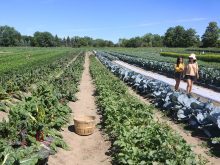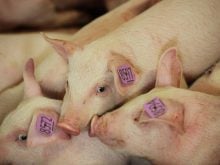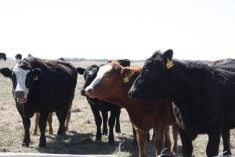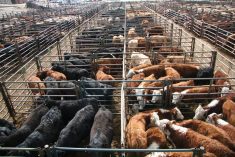A cold spring and soggy pastures could force changes to grazing plans.
“For every day you turn out too early in the spring, you lose about three or four days in the fall,” said beef specialist Pat Ramsay of Alberta Agriculture.
Producers make trade-offs this time of year. They prefer to get cattle out of muddy corrals to prevent disease problems, but pastures are probably two to three weeks behind normal development.
This means figuring out an alternative plan to protect tender growing plants and vulnerable soils.
Read Also

Canada told trade crisis solutions in its hands
Canadians and Canadian exporters need to accept that the old rules of trade are over, and open access to the U.S. market may also be over, says the chief financial correspondent for CTV News.
Sod-forming grasses take more abuse than tame grasses, which Ramsay said means they should perhaps be grazed first.
Producers are advised in an average year to wait until plants are at the 3.5 leaf stage and 15 millimetres tall before turning out the cows.
“There is no one recipe for grazing management and when we use rules of thumb, the minute you say them, they are wrong,” said forage specialist Grant Lastiwka of Alberta Agriculture.
“But on average they are sound.” The situation has changed this year because parched soil in some parts of the West did not freeze while soils with excess moisture and cold experienced deep, penetrating frost.
“As the frost comes out of it and there is so much moisture present in it, soil structure loses its integrity,” Lastiwka said.
“We have animals that when they are on this type of ground, sink deep, damage soil structure, push air out of soil and leave ruts in some cases. All of that means that land does not function as well afterwards.”
Too much moisture means less nutritional value in the forage and more leaching of soil nutrients.
“We have a larger yield of a less nutrient dense plant,” he said.
“Our plants’ production has to be in balance with the nutrients under it.”
The challenge in these conditions is to keep cattle moving to prevent them from damaging the land. Micro-organisms cannot breathe well and the soil cannot properly hold and release water.
“They in fact become a poorer ecosystem in terms of providing a very effective habitat for nutrient cycling, for the plants’ root systems to function well at accessing nutrients and water,” he said.
Drier pastures can withstand earlier grazing in wet conditions with less damage, as can those with more sod or fields with stockpiled forage from last year.
“Pastures are perennial. What happens to them doesn’t happen over night and doesn’t turn around and give back immediately,” Lastiwka said. “I would much rather have a spring with good water and good soil moisture to know that if I do hold the cattle back a little longer, I’m going to have grass.”
Drought from past years lowered the water table in many parts of Alberta, but wetter conditions can replenish the supply.
Producers also need to remember that the growing season and grazing season are different. There are 60 to 80 days of growth in good conditions with adequate moisture, adequate minerals to provide nutrition, heat and species that can perform well in that environment.
Grazing seasons are much longer so producers need to take care of the forage to provide optimum nutrition for the livestock.















